Well, we have the following circuit:

simulate this circuit – Schematic created using CircuitLab
I used Mathematica to write a code using KCL and KVL. The code I came up with is the following:
FullSimplify[
Solve[{Iin == I1 + I2, I3 == I2 + β1*I2,
0 == I4 + I5 + β1*I2, Ie == I5 + β2*I5, Ie == I6 + I7,
I1 == Ia + Iin, Ib == I3 + Ia, 0 == I4 + Ib + Ic,
Id == Ic + β2*I5, Id == I6 + I7, I1 == (Vin)/R1,
I2 == (Vin - V1)/R2, I3 == (V1)/R3, I4 == (V2)/R4,
I5 == (V2 - V3)/R5, I6 == (V3)/R6, I7 == (V3)/R7}, {Iin, I1, I2,
I3, I4, I5, I6, I7, Ia, Ib, Ic, Id, Ie, V1, V2, V3}]]
Using your values I got the following code:
FullSimplify[
Solve[{Iin == I1 + I2, I3 == I2 + β1*I2,
0 == I4 + I5 + β1*I2, Ie == I5 + β2*I5, Ie == I6 + I7,
I1 == Ia + Iin, Ib == I3 + Ia, 0 == I4 + Ib + Ic,
Id == Ic + β2*I5, Id == I6 + I7, I1 == (Vin)/100000,
I2 == (Vin - V1)/1530, I3 == (V1)/R3, I4 == (V2)/2200,
I5 == (V2 - V3)/359, I6 == (V3)/300, I7 == (V3)/200}, {Iin, I1, I2,
I3, I4, I5, I6, I7, Ia, Ib, Ic, Id, Ie, V1, V2, V3}]]
I left \$\text{R}_3\$ as it was because I need to set it equal to \$0\$ and than I will get an error message because then I will divide by \$0\$. Later I will take the limit.
Entering the code I got the following result:
{{Iin -> Vin (1/100000 + 1/(1530 + R3 + R3 β1)),
I1 -> Vin/100000, I2 -> Vin/(1530 + R3 + R3 β1),
I3 -> (Vin (1 + β1))/(1530 + R3 + R3 β1),
I4 -> -((Vin β1 (479 + 120 β2))/(
3 (1530 + R3 + R3 β1) (893 + 40 β2))),
I5 -> -((2200 Vin β1)/(
3 (1530 + R3 + R3 β1) (893 + 40 β2))),
I6 -> -((880 Vin β1 (1 + β2))/(
3 (1530 + R3 + R3 β1) (893 + 40 β2))),
I7 -> -((440 Vin β1 (1 + β2))/((1530 + R3 +
R3 β1) (893 + 40 β2))),
Ia -> -(Vin/(1530 + R3 + R3 β1)),
Ib -> (Vin β1)/(1530 + R3 + R3 β1),
Ic -> -((2200 Vin β1)/(
3 (1530 + R3 + R3 β1) (893 + 40 β2))),
Id -> -((2200 Vin β1 (1 + β2))/(
3 (1530 + R3 + R3 β1) (893 + 40 β2))),
Ie -> -((2200 Vin β1 (1 + β2))/(
3 (1530 + R3 + R3 β1) (893 + 40 β2))),
V1 -> (R3 Vin (1 + β1))/(1530 + R3 + R3 β1),
V2 -> -((2200 Vin β1 (479 + 120 β2))/(
3 (1530 + R3 + R3 β1) (893 + 40 β2))),
V3 -> -((88000 Vin β1 (1 + β2))/((1530 + R3 +
R3 β1) (893 + 40 β2)))}}
Now using your gain formula we will end up with:
$$\text{G}:=\frac{\text{V}_3}{\text{V}_\text{in}}=\lim_{\text{R}_3\to0}-\frac{88000\beta_1\left(1+\beta_2\right)}{\left(1530+\text{R}_3\left(1+\beta_1\right)\right)\left(893+40\beta_2\right)}=$$
$$-\frac{8800\beta_1\left(1+\beta_2\right)}{153\left(893+40\beta_2\right)}\tag1$$

